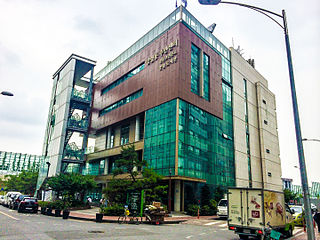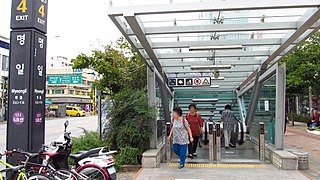Related Research Articles

Gwangmyeong is a city in Gyeonggi Province, South Korea. It borders Seoul to the east, north and northeast, Anyang to the southeast, Siheung to the southwest, and Bucheon to the northeast.

Yeongdeungpo District is an administrative district in southwest Seoul, South Korea. Although the origin of the name is uncertain, the first two syllables are thought to be from "yeongdeung" (靈登) or "divine ascent", a shamanic rite. The third syllable is "po", representing the bank of a river (浦), referring to the district's position on the Han River. The 2006 population was 408,819.

In Seoul, public transit buses are operated by the Seoul Metropolitan Government and private bus operators.

Gangdong District (Gangdong-gu) is one of the 25 gu which makes up the city of Seoul. Gangdong, literally means "east of river".

Seongdong District (Seongdong-gu) is one of the 25 gu which make up the city of Seoul, South Korea. It is situated on the north bank of the Han River. It is divided into 20 dong (neighbourhoods).

Dongdaemun District is one of the 25 districts of Seoul, South Korea.

Gwangjin District is one of the 25 districts of Seoul, South Korea. It is located on the north bank of the Han River on the eastern end of Seoul. The district was split from the neighboring Seongdong District in 1995.

Pungnap-dong is a neighbourhood, dong of Songpa-gu, Seoul, South Korea.

Amsa-dong is a dong (neighbourhood) of Gangdong-gu in Seoul, South Korea. The dong is well known for the Amsa-dong Prehistoric Settlement Site, in which Neolithic remains were excavated after a large amount of diagonal-line patterned earthenware was exposed by a flood in 1925.

Cheonho-dong (Korean: 천호동) is a dong, neighbourhood of Gangdong-gu in Seoul, South Korea.

Seongnae-dong is a dong, neighbourhood of Gangdong-gu in Seoul, South Korea.

Gangil-dong is a dong, neighbourhood of Gangdong-gu in Seoul, South Korea.

Godeok-dong is a dong, neighbourhood of Gangdong-gu in Seoul, South Korea.

Dunchon-dong is a dong, neighbourhood of Gangdong-gu in Seoul, South Korea.

Gil-dong is a dong, neighbourhood of Gangdong District in Seoul, South Korea.
Sangil-dong is a dong, neighbourhood of Gangdong-gu in Seoul, South Korea.

Mok-dong is a ward of Yangcheon-gu, located in the west of Seoul, South Korea. Commonly referred to as a "special education district", the upper-middle/upper-class neighborhood is best known for its abundance of private institutions, or Hagwons, as well as quality public schools. It is also home to the headquarters of two broadcasting corporations, SBS and CBS. Also situated in Mok-dong are the Hyperion Towers, the tallest of which is 69 stories and 256 metres high. The tallest tower, Tower A, is the fifth tallest skyscraper in Seoul and one of the tallest residential buildings globally. During the Joseon Dynasty, it was used as a ranch where horses were grazed by many trees and was now transformed into a wooden area.

Gubeundari Station is a subway station on Seoul Subway Line 5 in Gangdong-gu, Seoul.

Myeongil Station is a subway station on Seoul Subway Line 5 in Gangdong-gu, Seoul.
Postal codes in South Korea are composed of five digits. A new system of post codes was introduced on August 1, 2015. The first postal code in South Korea was established on July 1, 1970, and has been revised three times: in 1988, 2000, and 2015.
References
- 1 2 3 "명일동 (Myeongil-dong 明逸洞)" (in Korean). Doosan Encyclopedia. Retrieved 2021-11-16.